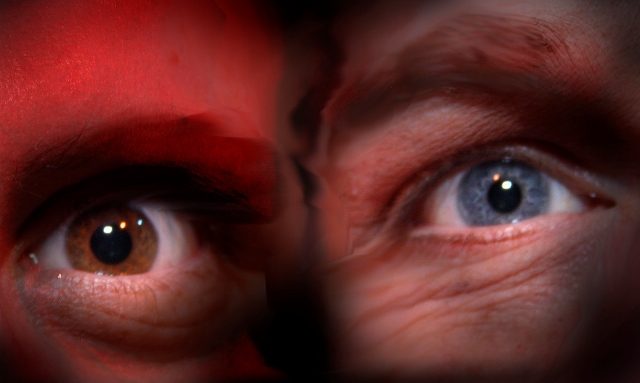
Each character in the story has a dark side. There are five "Hydes" in this unusual Jeffrey Hatcher adaptation of the Robert Louis Stevenson story. L to R: Bill Lamack, Linda Friday, Cameron Purdy, Barry Crush and Geoff Yaraoschak. (Photo credit: Colleen Algeo)
Robert Louis Stevenson’s DR. JEKYLL AND MR HYDE has continued to fascinate audiences since the novella first appeared in 1886. The first theatrical adaptation, for the great actor Richard Mansfield, appeared one year later and JEKYLL has remained popular in film and theater versions ever since. This adaptation by Jeffrey Hatcher, currently presented by the DCP Theatre in Telford, strips away years of tradition and artifice and returns to the themes of the original work.
Stevenson was fascinated by the concept of good and evil. In most Victorian plays and novels of his time, characters tended to be one or the other. Stevenson believed that good and evil existed in mankind at all times: we try to be good but are constantly at war with our natural instincts. The character of Dr. Jekyll, a brilliant scientist, who is also an agnostic misanthrope, tries to separate the two and uses himself in his experiment. He devises a potion that turns him into Mr. Hyde, who has all the tendencies toward drunkenness, sexual depravity, and murderous rage that the good doctor lacks. Eventually, Hyde becomes the dominant character threatening to destroy Jekyll entirely.
It’s an exciting story, but one whose themes have been obliterated by years of melodramatic traditions. Mansfield’s first adaptation featured a tremendous transformation scene that was so powerfully performed that it tended to eclipse the rest of the play. From that time on, audiences remembered Jekyll turning into Hyde and forgot Stevenson’s original themes.
Modern playwright Jeffrey Hatcher, who had already scored with a successful adaptation of THE TURN OF THE SCREW, desired a more faithful version. He eliminated the transformation scene, and suggested that Hyde be played by 4 members of the acting ensemble. Each Hyde would be distinct, illustrating a unique aspect of man’s depravity. Stevenson told the story not in a traditional way, but through letters and documents, a facet that Hatcher captures as well.
The combined forces of Arizona and San Jose Rep Theatres commissioned the play. Hatcher knew that both companies had strong actors, seasoned on Shakespeare and Wilde, who could easily handle the murky depths of the characterizations, and the fruity language, much of which came right out of the novella. He knew that he could limit the cast to 10 skilled performers who could master the Victorian milieu, and impersonate dozens of characters of all stations and accents. Finally, he knew that the designers could develop, on a limited budget, the numerous scenes his quick-change scenario called for.

CAST PHOTO with Director Patrick Gallagher (far left) and Producer, Rachael Gallagher (top right); Ensemble roles Kent Gerhart (top middle). (Photo credit: Colleen Algeo)
The DCP Theater is unable to meet Hatcher and Stevenson’s demands. Set designer Patrick Gallagher has done director Patrick Gallagher no favors. The stage is dominated by a distracting monstrosity that manages to squash the theatrical possibilities of every scene. Many of the scenes occur in Jekyll’s office which is confined to a narrow strip featuring a small desk and a piano bench. The actors are confined to standing or sitting on the bench. When more then 3 actors are in the scene they resemble a police line up. Is it any wonder the performers are uncomfortable?
Many scenes are staged downstage with the cast merely standing about talking to one another. An inventive production scheme for the Victorian scenes might have helped the actors to be more convincing as upper-class Englishmen, could have helped them focus their intentions, and allowed the staging to assist the audience in understanding the meaning of the scenes. In addition, all of the male characters wear the same exact costume, which adds to the bewilderment.
This play requires players, (with ample physical and vocal skills, not to mention the many dialects), to instantly become dozens of varied characters. In this case the performances are totally confounding, (with Walter Bender offering a pleasing cameo as an obnoxious surgeon).
Cameron Purdy, as Jekyll, is a nice enough chap, but barely scratches the surface of the character’s inner turmoil, self-contempt, and torment. None of the scenes illustrate the depths of depravity portrayed in the play.
Hatcher intended his short scenes to be performed quickly, gradually building to a terrifying climax. This production has the actors waiting for music to finish and the lights to rise before beginning a new scene. The pacing is glacial.
When the lights came up for the intermission, the audience began buzzing. “Do you know what’s going on? There are how many Hydes?” and the most overheard comment: “I’m confused.”
Regrettably, Hatcher, Stevenson and DCP were not a good match.
DR. JEKYLL & MR. HYDE
by Jeffrey Hatcher
Based on the Novella by Robert Louis Stevenson
Directed by Patrick Gallagher
November 4-November 20, 2011
DCP Theatre
795 Ridge Road
Telford, PA
215-234-0996
www.dcptheatre.com


